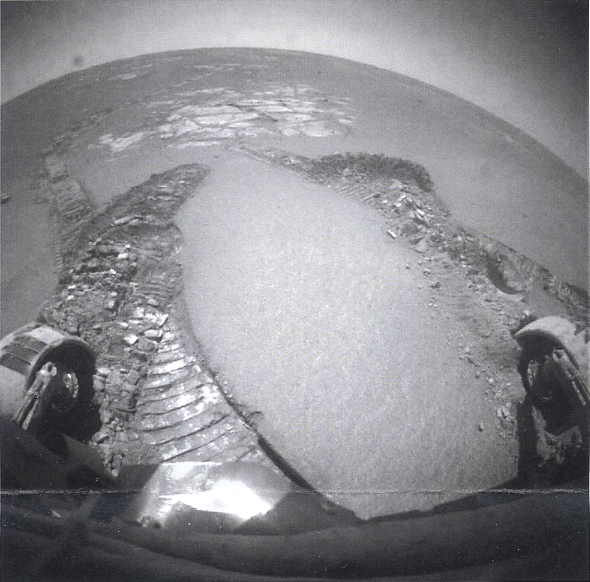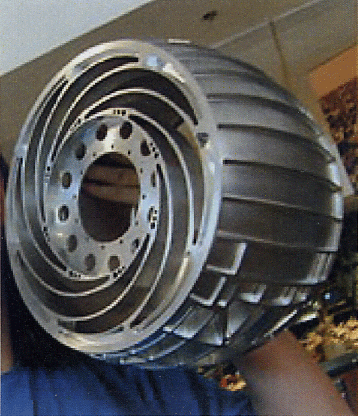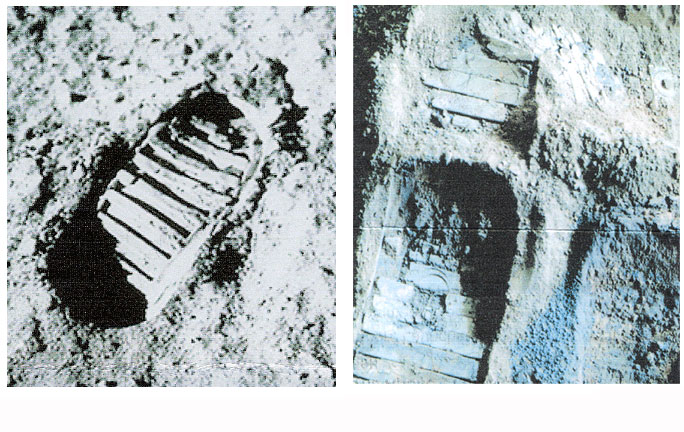So, You See, As Nibiru Orbits...
From Our Readers
The Case of The 'Yo-Yo Planet'
NICE NEWS FROM THE 'NICE GROUP'
Global Warming: WILL TECHNOLOGIES OF THE GODS COME TO THE RESCUE?
Science News: NEW DISCOVERIES CORROBORATE SITCHIN
"ENKI", "NIBIRU" DOMINATE "2012" SYMPOSIUM
EXCITING DISCOVERY IN THE SOUTHERN FISH
THE ENIGMA OF THE ‘PHAESTOS DISC’
IS THE PAST OUR FUTURE?
AS I WAS SAYING…
SO WHAT IS IT?
EXISTENCE OF SECRET CHAMBER IN GREAT PYRAMID REVEALED BY NEW STARTLING BOOK
ROBBING PLUTO OF ITS PLANETHOOD: Leave It The Way The Sumerians Had It Says Author Zecharia Sitchin
In The Media
In The Media: FATE Magazine, May 2006
When Calamity Strikes Mankind: THE "TSUNAMI" OF 10,900 B.C.
Q & A
SO WHAT IS IT?
Several weeks ago, a photograph (Fig. 1) was posted here and readers were asked, “What is it?” The correct answer: It is a photograph from the surface of Mars. Specifically, according to NASA: Wheel prints of the Mars rover Opportunity in Meridiani Planum, showing a cluster of greenish tiny balls (nicknamed “Blueberries”) of hematite (iron oxide) that can form only in the presence of water.
When I first saw this photograph (in an issue of The Planetary Report) I scratched my head. The rover, as (Fig. 2) shows, moves on six wheels -- three on each side. The wheel treadprints, as (Fig. 3) shows, form continuous double tracks. Yet here there is a distinct untreaded break, a disconnection; how is that possible, if the camera is looking back on where the rover had passed? Also, the wheels (see Fig. 4) are slightly convex (like the boards in a wooden barrel), leaving (see Fig. 3) a slightly rounded imprint; yet here the segments are perfect elongated 90º rectangulars. And they are laid out tightly like stone slabs next to each other, without the separation between the “slabs” that must be caused by the wheels’ ribs. How come?
The circular indentations (bottom left, upper right) in (Fig.1 ) are explained by NASA’s analysts as the marks left by Mossbauer Spectrometer as it punches the soil to analyze it. But that instrument (see Fig. 2) lies in the rover between the two rows of wheels; yet the bottom left circular imprint is smack within the wheelprint. How can it be? This imprint is also different from both the one on the upper right (made by Opportunity’s instrument) and an imprint (Fig. 5) left by the similar instrument on the twin rover Spirit (that roams on the other side of Mars). The difference remains unexplained.
In response to the question “What Is It?”, scores of answers were mailed in -- from all over the world. A few answered it exactly NASA’s way: Pribyl Frantisek of the Czech Republic; Frank Rumore of New Jersey; Mark Keller of Virginia; Mrs. B.J. Stewart from Canada; Bill Stanley of Tennesee; Mark Miller of Appleton, Wisconsin and Tony Giovanni of Nevada.
Most of the other answers suggested a “footprint” of sorts on the Moon or Mars. Many realized that the “Blueberries” indicated a site on Mars; but, as some explained, the ‘disconnection’ suggested a bootprint rather than a wheel’s track, so it had to be where Man had gone: The “footprint” of an Apollo astronaut’s boot on the Moon (Fig. 6a).
What threw them off, and the other discrepancies detailed above, remain cause for continued headscratching.
March 2008 Zecharia























